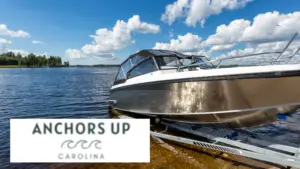Boat owners face challenges whether they keep the boat at a dock, dry rack, or on the trailer. However, trailering a vessel adds an extra element of stress. I have towed my personal boats and boats for companies I have worked for over the years. Towing boats comes with challenges, so it is important to understand how to avoid potential issues. Learn 10 tips on how to trailer a boat.
Watch Your Speed
Without question, speed is a major issue when trailering a boat. Take into consideration the added weight behind the tow vehicle. First, understand that you will not be able to stop as quickly as you would without the boat in tow.
In addition to the delay in stopping distance is fuel economy. When you’re towing along the added weight, the vehicle will burn gasoline or diesel at a significantly higher rate. One of the best approaches to reducing fuel burn is to slow down and remain at the posted speed limit.
Wet Roads Are Slippery
Slippery roads are disastrous for trailers. One rainy afternoon, my vehicle slid down the exit ramp of I-95 while the trailer swayed from side to side. Fortunately, I was able to regain traction without losing control.
Whenever the roads are slippery, it is important to increase your distance between the vehicles ahead and slow down. Allow extra time to stop if traffic comes to a halt at a rapid rate.
Don’t Be Distracted
First off, put down the phone when trailering a boat. Reaction time is critical, and a cell phone is the number one on the list of distractions.
In addition to putting down the phone, it is limiting your time adjusting the tunes. Focus on the road ahead, change up the music when the vehicle, boat, and trailer are at a standstill compared to underway.
Secure All Items On The Boat
No matter if you’re leaving for the launch or headed home, ensure that all items aboard the boat are secured.
Unfortunately, boaters lose valuable equipment annually. Light items are tossed out of the boat while on roadways and highways. One of the most commonly lost items is the throwable device. The throwable is required to be placed outside of a hatch where it is easily accessed. For this reason, it isn’t stowed before trailering and, therefore goes airborne over the side. However, more valuable items, including backpacks, fishing bags, and more, tend to do the same.
Remove all items at risk of blowing out of the boat while it is being towed down the road.
Check The Tongue And Ball
No question about it: the ball and trailer tongue are the most critical components to connecting the trailer to the tow vehicle.
Ensure the tongue is seated on the ball before positioning the coupler latch. A trailer may appear to be properly secured despite it sitting in an improper position. I suggest connecting the trailer, stepping away, and rechecking or having a family member or friend inspect before getting underway.
Grease The Trailer Bearings
The last thing you want to have happen is a bearing seize while trailering a boat. It is unlikely you will have a spare boat trailer hub and tools on hand to make the swap.
Rather than dealing with mechanical failure on the road, ensure to maintain your trailer bearings. The bearings must be serviced per the manufacturer’s requirements. However, this will include periodic applications of grease with a grease gun. Failing to grease hubs will create friction and cause the bearing to seize.
Walk Around The Boat And Trailer
Walking around the boat and the trailer is essential before getting underway with the tow vehicle.
Without a doubt, making a loop around the vessel and trailer will help you to identify potential risks. Some of the risks include securing the ball to the trailer, loose covers, missing stern straps, and more.
I often drive a minimal distance before taking a second walk around to ensure that everything is secured properly. Knowing how to trailer a boat goes beyond being underway.
Trim Up The Motor
I’ll start by saying that I have dragged my motor against the boat ramp because I failed to trim the engine. Fortunately, I realized my mistake before entering public roadways.
Importantly, you must inspect the position of the motor before heading out. If the motor is trimmed low, it will contact the ground. Ensure that the engine is trimmed up and locked into position. Trust me, your lower unit and skeg will appreciate it.
Connect The Chains
Unfortunately, boats come free from the tow vehicle year after year. One of the best methods to prevent a trailer boat from disconnecting is properly securing the tow chains.
The chain’s purpose is to prevent the trailer from disconnecting if the ball and coupling separate. Importantly, the trailer chains must be crossed in the X position. The crossing of the chains is an added safety measure as it catches the coupling as opposed to dragging it on the ground. I have had this happen to me, but not with a boat; instead, it was a utility trailer.
Remove The Chocks
At the moment, it was a funny situation, but failing to remove chocks can cause serious issues. I was sitting in a marina and watched someone gun the engine, attempting to move the boat and trailer. Shockingly, the trailer failed to move because the chocks remained in place.
Yes, I assisted by informing the two men of the issue, which led to a verbal disagreement. However, they were able to proceed after removing the blocks.
The risk of failing to remove chocks before towing is damaging the axle. Unquestionably, the force applied to the axle that is unable to move can either bend or shift its position. Always remove the chocks. However, it didn’t make the list, but remember to put the chocks back in place when disconnecting the boat and trailer from the tow vessel.
How To Trailer A Boat: Be Smart
Being smart by using your brain is critical when it comes to how to trailer a boat. Yes, towing boats is stressful, so don’t add on pressure by failing to consider these 10 safety tips. I have felt the pressure of towing in the rain and other poor conditions. Without a doubt, you’re putting yourself at an advantage when remembering 10 boat trailering safety tips.




